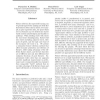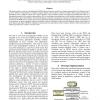138 search results - page 4 / 28 » Improving Word Sense Disambiguation Using Topic Features |
ANLP
2000
13 years 6 months ago
2000
We have developed a word sense disambiguation algorithm, following Cheng and Wilensky (1997), to disambiguate among WordNet synsets. This algorithm is to be used in a cross-langua...
JMLR
2010
12 years 12 months ago
2010
Feature selection for supervised learning can be greatly improved by making use of the fact that features often come in classes. For example, in gene expression data, the genes wh...
CICLING
2007
Springer
13 years 11 months ago
2007
Springer
Distributions of the senses of words are often highly skewed. This fact is exploited by word sense disambiguation (WSD) systems which back off to the predominant (most frequent) s...
ECAI
2000
Springer
13 years 9 months ago
2000
Springer
Abstract. This paper describes an experimental comparison between two standard supervised learning methods, namely Naive Bayes and Exemplar–basedclassification, on the Word Sens...
LREC
2010
13 years 6 months ago
2010
This paper presents a word sense disambiguation (WSD) approach based on syntactic and logical representations. The objective here is to run a number of experiments to compare stan...


